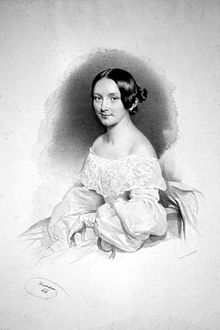Luise Neumann

Luise Neumann , occasionally Louise Neumann , (born December 7, 1818 in Karlsruhe , † October 17, 1905 in Rabensburg ) was a German actress.
Life
Neumann was a daughter of the actor couple Amalie Haizinger and Carl Neumann ; the future actress Adolfine Neumann (1822-1844) was her younger sister. She received her first artistic lessons from her mother and was able to make her debut on April 25, 1835 at the city theater in Breslau as "Walpurgis" in Carl Loewes Goldschmieds Töchterlein .
In the same year Neuman received an engagement at the court theater in her hometown. Already on October 16, 1839, she was there for the first time on stage as "Christine" in Königin at the age of 16 . From there she went to Vienna at the Hoftheater and made her debut there very successfully in Der aufrichtige Freund as "Hannchen". Until her marriage to Karl Reichsgraf von Schönfeldt (1828–1886) (who was ten years her junior ) on January 14, 1857, she remained connected to the court theater; She gave her official farewell performance on December 19, 1856 in the role of Lorle and Leonore in the village and town of Charlotte Birch-Pfeiffer (1800–1868).
reception
Luise Neumann was the audience's favorite. Even critics like Heinrich Anschütz and Ludwig Speidel left no doubt about it in their reviews for years. One focus of her artistic work was the subject of naive and sentimental lovers and the exclamation Voila, une actrice! (“That's an actress!”) Is rumored by Émile Zola .
Her grandson was Carl von Schönfeldt, who became known as a quiz master at ORF in Austria under the pseudonym Rudolf Hornegg .
Roles (selection)
- Walpurgis - Goldsmith's Daughters ( Carl Loewe )
- Julie - The German Housewife ( August von Kotzebue )
- Christine - Queen of 16 years ( Theodor Hell )
- Hannchen - a sincere friend ( Franz August von Kurländer )
- Lorle - Village and City ( Charlotte Birch-Pfeiffer )
- Beatrice - Much Ado About Nothing ( William Shakespeare )
- Minna - Minna von Barnhelm ( Gotthold Ephraim Lessing )
- Ida - The Jesuit and his pupil (Johannes Krüger)
Quote
Heinrich Anschütz in his memoirs of 1866:
- In her outward appearance, Louise Neumann was well equipped for her profession through the gifts of nature. Her features were regular, very pleasant by a predominantly friendly and cheerful tone, and enlivened by a brilliant eye from which spirit and moral purity spoke and which was capable of every expression; the shapely mouth moved delicately and showed the most beautiful teeth. The figure was only of medium size, was of pleasant, round shape, and all these details became the most enchanting ( sic! ) Whole with a gift that only nature in the cradle bestows, with the grace of expression .
literature
- Heinrich Anschütz: memories. From his life and work. Based on handwritten notes and verbal reports . Sommer, Vienna 1866; archive.org .
-
Heinrich Laube : The Burgtheater. A contribution to German theater history . Weber, Leipzig 1868.
- Second edition, Haessel, Leipzig 1891; archive.org .
- Gustav zu Putlitz : Theater memories . Volume 1. Paetel, Berlin 1875, pp. 26, 136, 227; archive.org .
- Constantin von Wurzbach : Neumann, Luise . In: Biographisches Lexikon des Kaiserthums Oesterreich . 20th part. Kaiserlich-Königliche Hof- und Staatsdruckerei, Vienna 1869, pp. 276–279 ( digitized version ).
- Ludwig Eisenberg : Luise Neumann . In: Large biographical lexicon of the German stage in the XIX. Century. Paul List, Leipzig 1903, p. 720 ( daten.digitale-sammlungen.de ).
- E (dgar) Marktl: Schönfeldt (Schönfeld) Luise Reichgfn. from. In: Austrian Biographical Lexicon 1815–1950 (ÖBL). Volume 11, Verlag der Österreichischen Akademie der Wissenschaften, Vienna 1999, ISBN 3-7001-2803-7 , p. 80.
Web links
Individual evidence
- ↑ E (dith) Wohlgemuth: Schönfeldt (Schoenfeld), Karl (Filipp Hilmar Adolf) Reichsgf. von (1828–1886), officer. In: Austrian Biographical Lexicon 1815–1950 (ÖBL). Volume 11, Verlag der Österreichischen Akademie der Wissenschaften, Vienna 1999, ISBN 3-7001-2803-7 , p. 79 f. (Direct links on p. 79 , p. 80 ).
- ↑ KK Hof-Burgtheater. (...) village and city. In: Burgtheater theater ticket , December 19, 1856, p. 2. (Online at ANNO ).
| personal data | |
|---|---|
| SURNAME | Neumann, Luise |
| ALTERNATIVE NAMES | Neumann, Louise |
| BRIEF DESCRIPTION | German-Austrian actress |
| DATE OF BIRTH | December 7, 1818 |
| PLACE OF BIRTH | Karlsruhe |
| DATE OF DEATH | 17th October 1905 |
| Place of death | Rabensburg |